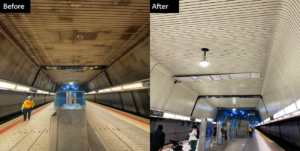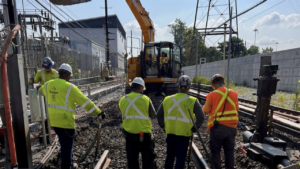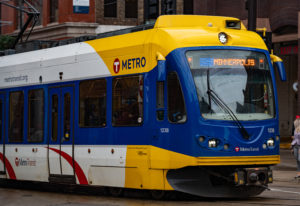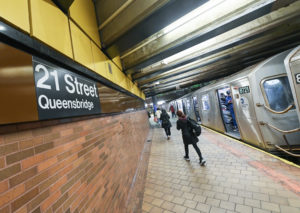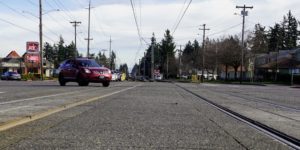A steady road to shortline success
Written by Mischa Wanek-Libman, editor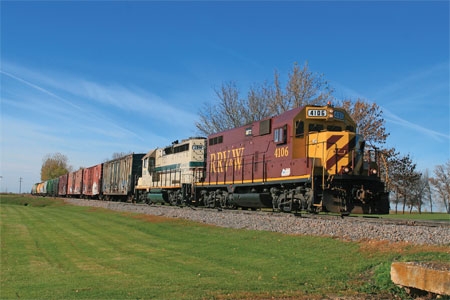
Minnesota Prairie Line proves it takes more than a history of challenges, an end in service and the threat of abandonment to keep a dedicated shortline down.
{besps}April13_shortline{/besps} {besps_c}0|1shortline13.jpg|An MPL train with a locomotive from sister company Red River Valley & Western Railroad, near Arlington, Minn. Photo by Steve Glischinski.{/besps_c} {besps_c}0|2shortline13.jpg|Just a taste of what MPL found waiting prior to commencing rehabilitation efforts along the 94-mile line. Photo courtesy of MPL.{/besps_c} {besps_c}0|3shortline13.jpg|A contractor working to replace a section of rail. Photo courtesy of MPL.{/besps_c}
Minnesota Prairie Line proves it takes more than a history of challenges, an end in service and the threat of abandonment to keep a dedicated shortline down.
A 94-mile rail line between Norwood and Hanley Falls, Minn., with a diverse service portfolio, well-maintained infrastructure and the support of the local community, sounds like a healthy railroad and it is. But this wasn’t always the case.
The line, now operated by Minnesota Prairie Line (MPL), a subsidiary of the Twin Cities & Western Railroad Company (TC&W), dates back to the 1880s when it was built by the Minneapolis & St. Louis Railway and then sold to the Chicago & North Western Railway (C&NW) in 1960. By 1982, the track structure and traffic had declined to a point that C&NW began abandonment proceedings. Several counties served by the line recognized its importance and formed the Minnesota Valley Regional Rail Authority (MVRRA) to purchase and save the line in 1983.
MVRRA hired a series of railroad operators over the next two decades, during which the line fell into further disrepair. A previous operator had placed zero liability into the freight rates for derailments and it was not uncommon for a train to derail four times while traveling along a 60-mile route and in 2000, operations ceased.
The line had poor ties and surface conditions, as well as a lack of ballast when MPL was chosed to operate the route. By this time, MVRRA had developed a plan to ready the infrastructure for a return in service.
Once known as the line of the standing derailment, the infrastructure and service has turned around with good planning and a group of stakeholders who have shown fierce commitment toward the route’s success.
Reflecting on the line’s condition when MPL first took over operations, Mark Wegner, president of TC&W, said, “It was a tough case and it took a lot of believers.”
Initial rehab program
MVRRA developed a three-phase rehabilitation plan: Phase 1 would reopen the railroad; Phase 2 would upgrade the line to 25 mph and Phase 3 would upgrade the rail in order to handle 286k gross weight. MPL was chosen as the operator in 2000 and by 2002, work to prepare the line’s return to service was underway.
Approximately 80,000 new wood crossties were installed, 81,500 tons of ballast was used and additional rail inventory was acquired to replace the worst of the vertical split head rails, which included a four-mile stretch of 70-pound rail. Additionally, there were 39 crossings ranging from 24-feet to 36-feet in length that were replaced to enable 10 mph operations across the entire 94-mile route.
Wegner described the notoriously harsh Minnesota winter lending a hand to the rehab effort when there was a need to move ballast more than half way over the line on track that had been out of service for two years. Doing so in winter, when the track was frozen, allowed the ballast transport to be a success and reduced any potential derailment concerns.
As rail operator, MPL was responsible for performing a lot of prep work before the main contractor reached a portion of track to rehab. Wegner said part of this challenge was making sure the track structure held together so the contractor’s machines would not derail as they traveled along, but MPL also had to make sure all material was ready for the contractor.
“The last thing you want is the contractor sitting,” said Wegner. “That was the biggest challenge, making sure that the contractor was working at all times and to have the material and track ready for them.”
Going back to those Minnesota winters, Wegner mentions that the rehab project did have a seasonal time limit and by October 2002, the line’s first freight train ran on the eastern edge of the route, as the contractors were finishing up work along the western end.
Funding for the initial rehabilitation, which cost approximately $7.5 million, came from several sources including $4.8 million from the state of Minnesota, $600,000 from the MVRRA, $600,000 from a shippers group, along with contributions from the TC&W and federal funds.
Ongoing work
Freight traffic returning to the line wasn’t the end of rehab efforts. Since 2002, rehabilitation work has been ongoing. The first four miles of the line are jointed 115-pound rail, but the next 25 miles have been replaced with 115-pound continuous welded rail, which replaced 80-pound rail. The rail upgrade has allowed train speeds to increase from 10 mph to 25 mph between Norwood and Winthrop, Minn.
MVRRA protected its rehabbed asset within the operation agreement, which contractually obligates MPL to maintain the line to the condition in which it is rehabilitated. MPL submits a work plan to the Minnesota Department of Transportation for review on an annual basis.
“It’s kind of a neat deal. Whatever work has been done to-date, we have to maintain it to those conditions,” said Wegner. “Basically, the public investment in this public rail line is protected because we have to maintain it so it won’t go back to disrepair.”
While Wegner says the initial rehab project took care of tie and surface conditions, rail and the 18 bridges along the line are the current focus of the work effort.
“The three-phase maintenance plan has been modified to a degree in that the bridges under the heavier rail are being rehabbed to allow a 286k standard before the entire 94 miles of rail has been replaced. The first 29 miles now have heavy rail and the four bridges in the first 29 miles will be rehabbed to 286k before rail is upgraded going west of the 29 miles,” said Wegner.
Key to success
Being a public rail line, collaboration with the various stakeholders is key to the line’s continued success. In addition to the monthly meetings MPL has with MVRRA to keep the lines of communication open, Wegner says paying attention to the small details also helps.
He uses vegetation as an example, “A private railroad might look at weeds and then at a busy schedule and get around to taking care of them within a month, but we can’t do that. Here, a weed is a local official’s visibility, so it’s incumbent upon us to address any issues, big or small, that can been seen on the rail line.”
Additionally, Wegner likes to tell a story from 2005 when MPL experienced a derailment right by a state highway about a week before Christmas. A contractor would not be able to clean up the derailment for a week due to a Class 1 derailment that occurred in the Twin Cities at the same time. Anticipating holiday travelers driving past the MPL derailment and thinking the railroad had wasted tax-payer money, Wegner called a local newspaper and explained what had happened, which led to a state representative contacting Wegner wanting to know more about the situation and the railroad.
“[The elected official] fired it up and really got things going at a state level and it’s one example of how an unfortunate incident can be turned around to positive action,” said Wegner.
The collaborative effort from all stakeholders has not only preserved the line, but also enhanced rail service.
“From what was once dormant and dilapidated track, the line has risen from the ashes, so to speak, and for more than 10 years, MPL customers have been able to safely and reliably make and receive shipments to and from markets throughout North America,” said Wegner.

